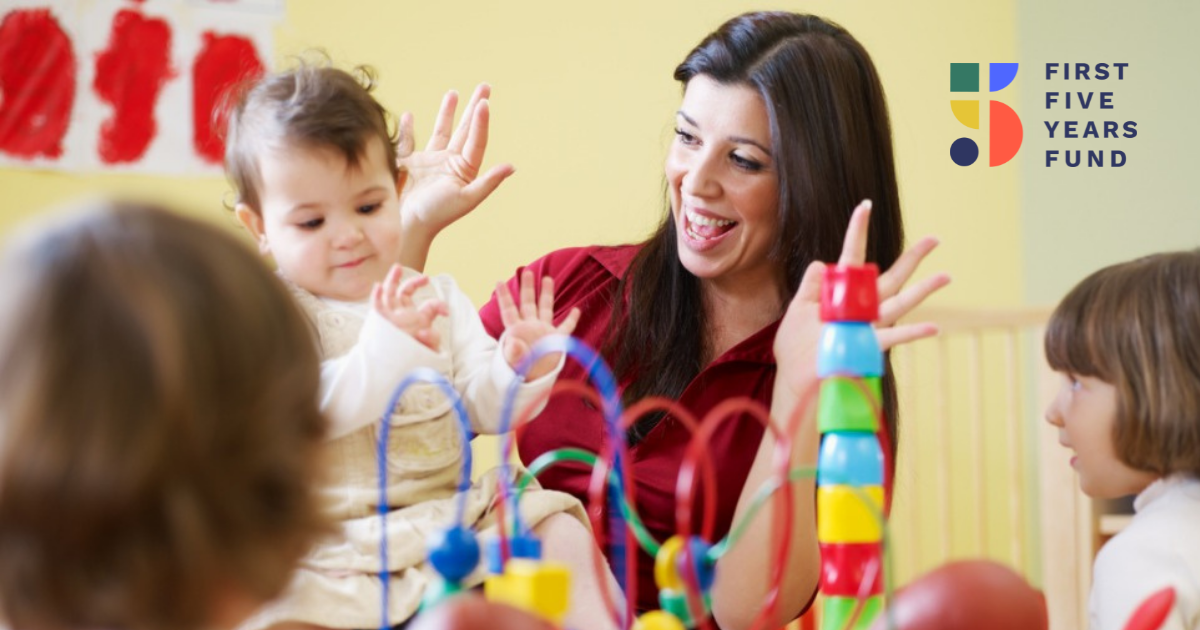How States Are Using PDG B-5 to Support Multilingual Learners
How States Are Using PDG B-5 to Support Multilingual Learners First Five Years Fund


Sustainable Development Goals and Supporting Multilingual Learners in PDG B-5 Applications

The BUILD Initiative, ZERO TO THREE, and Start Early, recently released a new brief highlighting the strategies states are using to support multilingual learners in their Preschool Development Grant Birth through Five (PDG B-5) applications. This brief highlights how PDG B-5 is being used to build the capacity of early care and education (ECE) systems, create infrastructure, provide direct services, and pilot new work in order to support multilingual learners. Their analysis found that states are employing different pilot programs and temporary strategies that are moving the needle in their states, but more federal funding is needed to ensure that they can see this work come to fruition and support young children and their families.
PDG B-5 Overview
PDG B-5 is a competitive federal grant designed to improve states’ ECE systems. In 2023, 21 states were awarded Planning Grants, and 21 states were awarded Renewal Grants. While the scope of work for planning grantees is to conduct comprehensive needs assessments and draft strategic plans, the renewal grantees focus on implementing their strategic plan. The 21 renewal grantees are using this infusion of federal funding across a wide range of content areas in their ECE systems, and in a variety of ways, such as by implementing compensation reforms, expanding professional development training, building the supply of child care, and streamlining administrative requirements.
In analyzing PDG B-5 grant applications, BUILD found that states have been charting their own course when it comes to ECE system development by working on a variety of projects and initiatives at once. They found that states tend to focus on shorter-term projects for their grants, perhaps because states do not see PDG B-5 as a reliable, continuous funding stream and lack confidence that state funding would be available to sustain the work. States may also be focusing on producing near-term results, or the broad framework of the grant may have led to more responsive strategies.
Multilingual Learners in Early Childhood Classrooms
Multilingual learners, or children who speak language(s) other than English, bring a rich tapestry of languages and cultures to early childhood classrooms. Approximately half of children birth to age two are multilingual, and 17% of children ages three, four, and five, are multilingual. Multilingual learners have many racial, ethnic, cultural, and linguistic assets, however, they face unique challenges in the education system that must be acknowledged and addressed to ensure their success. It is imperative that states provide a robust array of resources and supports to support multilingual learners effectively. This includes high-quality professional development for educators that encompasses strategies for culturally responsive teaching, language development, and effective communication with families who speak languages other than English. Additionally, instructional materials and curriculum resources that embrace linguistic and cultural diversity are crucial.
Multilingual learners have been identified as a vulnerable or underserved population in 27 of the 40 PDG B-5 applications that mention multilingual children. PDG B-5 funding allows states to support multilingual learners, and grantees are doing so through a variety of avenues such as engaging families as experts in their child’s language and culture, and promoting the needs of multilingual children and their families in local, state, and federal programs and policies, among others.
Strategies to Support Multilingual Learners in PDG B-5 Applications
- Making resources available in other languages
- Assuring they are culturally appropriate
- Providing training and technical assistance on language development for practitioners
- Providing degrees and credentials to support a multilingual workforce
- Recruiting and retaining a multilingual workforce
- Developing a common process to identify multilingual learners
- Supporting tribal language immersion and community engagement
PDG B-5 grants provide an opportunity for states to create supportive, targeted strategies. Click here to read more about all of the strategies states are pursuing and read on to see a few examples directly from BUILD of how states use PDG B-5 grant funds to support multilingual learners.
Translation of Resources
Translating resources is the most common activity in the PDG B-5 applications.
- 28 of the 42 states plan to use PDG funding to translate resources for families and/or practitioners.
- 15 states will review and revise resources to ensure they are culturally appropriate.
Training to Support Language Development
15 states plan to use PDG B-5 funding to create, expand, and/or enhance existing professional development supporting multilingual learners’ language development.
- Topics range from administering a culturally appropriate developmental screener, to including multilingual children in curriculum development, to ensuring teacher practices are culturally competent, among others.
Workforce Degrees and Credentials
Delaware, Massachusetts, and South Carolina will offer credentials, badges, or degrees to support multilingual learners.
- Although Delaware does not offer a specific credential or badge to support multilingual children, this state will offer support cohorts in multiple languages for CDA attainment and Associate’s and Bachelor’s degree completion. This state will also require higher education partners to teach coursework in Spanish and Haitian Creole.
Multilingual Workforce Recruitment and Retention
Idaho, Illinois, Mississippi, Ohio, and Virginia plan to use PDG B-5 funding to recruit and retain multilingual child care providers and lead or assistant teachers.
- Mississippi plans to provide bonuses for programs that employ a lead or assistant teacher who is fluent in a child’s home language. Child care providers serving families who do not speak English will receive a monthly subsidy bonus for employing a lead or assistant teacher who is fluent in a child’s home language.
Process to Identify Multilingual Learners
- Illinois will implement a common identification
SDGs, Targets, and Indicators in the Article
SDGs Addressed or Connected to the Issues Highlighted in the Article:
- SDG 4: Quality Education
- SDG 10: Reduced Inequalities
The article discusses the strategies and initiatives implemented by states to support multilingual learners in early childhood education, highlighting the importance of providing resources, training, and support for these learners. This aligns with SDG 4, which aims to ensure inclusive and equitable quality education for all. Additionally, the article emphasizes the need to address the unique challenges faced by multilingual learners, indicating a focus on reducing inequalities (SDG 10) in education.
Specific Targets under the SDGs:
- Target 4.2: By 2030, ensure that all girls and boys have access to quality early childhood development, care, and pre-primary education so that they are ready for primary education.
- Target 4.5: By 2030, eliminate gender disparities in education and ensure equal access to all levels of education and vocational training for the vulnerable, including persons with disabilities, indigenous peoples, and children in vulnerable situations.
- Target 10.2: By 2030, empower and promote the social, economic, and political inclusion of all, irrespective of age, sex, disability, race, ethnicity, origin, religion, or economic or other status.
The article focuses on providing support for multilingual learners in early childhood education, ensuring their readiness for primary education (Target 4.2). It also emphasizes the importance of addressing the needs of vulnerable populations, such as multilingual learners, to reduce inequalities in education (Target 10.2). While the article does not explicitly mention gender disparities, it highlights the importance of supporting all children, including those from diverse linguistic and cultural backgrounds, which aligns with Target 4.5.
Indicators Mentioned or Implied in the Article:
- Indicator 4.2.1: Proportion of children under 5 years of age who are developmentally on track in health, learning, and psychosocial well-being, by sex.
- Indicator 4.5.1: Parity indices (female/male, rural/urban, bottom/top wealth quintile, and others such as disability status, indigenous peoples, and conflict-affected, as data become available) for all education indicators on access, participation, and achievement in all levels of education.
- Indicator 10.2.1: Proportion of people living below 50 percent of median income, by age, sex, and persons with disabilities.
The article does not explicitly mention specific indicators. However, the mentioned targets can be measured using relevant indicators. Indicator 4.2.1 can be used to measure the progress towards ensuring that multilingual learners are developmentally on track in health, learning, and psychosocial well-being. Indicator 4.5.1 can be used to assess the gender disparities in access, participation, and achievement of multilingual learners in education. Indicator 10.2.1 can be used to measure the economic inclusion of multilingual learners and their families.
Table: SDGs, Targets, and Indicators
SDGs Targets Indicators SDG 4: Quality Education Target 4.2: By 2030, ensure that all girls and boys have access to quality early childhood development, care, and pre-primary education so that they are ready for primary education. Indicator 4.2.1: Proportion of children under 5 years of age who are developmentally on track in health, learning, and psychosocial well-being, by sex. SDG 10: Reduced Inequalities Target 4.5: By 2030, eliminate gender disparities in education and ensure equal access to all levels of education and vocational training for the vulnerable, including persons with disabilities, indigenous peoples, and children in vulnerable situations. Indicator 4.5.1: Parity indices (female/male, rural/urban, bottom/top wealth quintile, and others such as disability status, indigenous peoples, and conflict-affected, as data become available) for all education indicators on access, participation, and achievement in all levels of education. Target 10.2: By 2030, empower and promote the social, economic, and political inclusion of all, irrespective of age, sex, disability, race, ethnicity, origin, religion, or economic or other status. Indicator 10.2.1: Proportion of people living below 50 percent of median income, by age, sex, and persons with disabilities. Behold! This splendid article springs forth from the wellspring of knowledge, shaped by a wondrous proprietary AI technology that delved into a vast ocean of data, illuminating the path towards the Sustainable Development Goals. Remember that all rights are reserved by SDG Investors LLC, empowering us to champion progress together.
Source: ffyf.org

Join us, as fellow seekers of change, on a transformative journey at https://sdgtalks.ai/welcome, where you can become a member and actively contribute to shaping a brighter future.







